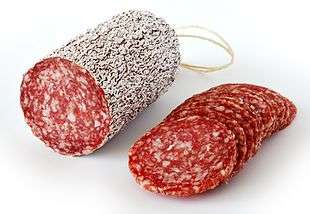Chả lụa

Chả lụa or giò lụa, is the most common type of sausage in Vietnamese cuisine, made of pork and traditionally wrapped in banana leaves. The term giò lụa (Vietnamese pronunciation: [zɔ̀ lûˀə] or [jɔ̀ lûˀə]) is part of the northern Vietnamese dialect, while chả lụa ([ca᷉ lûˀə]) is from the central and southern Vietnamese dialects.[1]
Production and consumption

Traditionally, chả lụa is made of lean pork, potato starch, garlic, ground black pepper and nước mắm (fish sauce). The pork has to be pounded until it becomes pasty; it cannot be chopped or ground as the meat would still be fibrous, dry, and crumbly. Near the end of the pounding period, a few spoonfuls of nước mắm are added to the meat for flavour, but salt, ground black pepper, and sugar can also be added. The meat is now called giò sống, meaning “raw sausage”, and can be used in other dishes as well.
The mixture is then wrapped tightly in banana leaves into a cylindrical shape and boiled. If the banana leaf is not wrapped tightly and water leaks inside while it is being boiled, the sausage will spoil easily if kept at room temperature. The sausage has to be submerged vertically into boiling water, and typically for a 1 kg sausage it takes an hour to cook. When making chả lụa by hand, a common way to tell if it is well cooked is to throw the sausage onto a hard surface; if it bounces, the sausage is good.
Other variants include:
- chả bì - containing shredded pork skin along with typical chả lụa ingredients, then steamed
- chả bò - beef sausage with herbs
- chả chiên - where the entire sausage is deep-fried (instead of steamed, omitting the banana leaf wrap)
- chả Huế - contains whole black peppercorns and more garlic and then steamed
- chả quế - sausage with seasoned with powdered cinnamon, then fried. Another variety of chả chiên.
Correctly made chả lụa can be stored at room temperature for about one week, but it is recommended to keep it refrigerated until used, where it can be stored for up to 3 - 4 weeks.
During the initial wave of Vietnamese immigrants to the United States in the mid-1970s, banana leaves were difficult to find and, thus, Vietnamese chefs substituted aluminum foil for banana leaves, a habit that continues today. In areas that have banana leaves, a small strip of it is used for flavor while still using the aluminum foil to shape the sausage.
The sausage is normally sliced and eaten with bánh cuốn, bánh mì, or xôi, or braised in fish sauce and black pepper with other meat dishes. If fried, it is called chả chiên.
See also
References
| Wikimedia Commons has media related to Giò lụa. |
